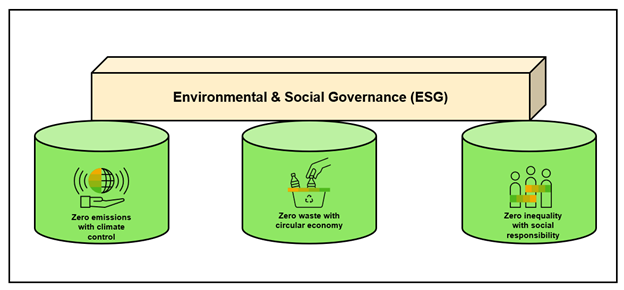Today, we will explore SAP capabilities and solutions. In 2022, SAP turned 50. During these 50 years, we’ve led, partnered with, and enabled hundreds of thousands of customers globally. We’ve helped customers to meet their top and bottom-line goals and targets. We realized early on that our responsibility to our customers includes the “green line.”
Our products and services need to help our customers operate in a sustainable, environmental, and socially friendly manner. We enable them to meet both local and global environmental and social governance (ESG) standards. They’re able to proactively address the concerns and rising pressure from investors, customers, regulators, and their own employees.
When our world is being ravaged alarmingly frequently by extreme climatic events because of our production and consumption behaviors, SAP’s commitment to sustainability can and will make a big difference to this planet, given our size, reach, influence, and leadership.
Our mantra is simple: make sustainability profitable and be profitably sustainable. We empower businesses to deliver sustainable products and services across all industries and networks. We enable the design, sourcing, manufacturing, and delivery of products and services to meet all critical profitability and green line targets.
Simply put, our solutions and capabilities transform businesses not simply into “Intelligent Enterprises,” but into intelligent and
sustainable enterprises. Our overarching goal, which is one we share with thousands of our customers and partners, is to make Planet Earth a better place to live in; not only for ourselves, but also for future generations.
Our aggressive and targeted approach to ESG enablement and excellence is built on three pillars, as shown in
Figure 1.

Our three-pronged approach can be called the “Three Zeroes” because we aim to help enterprises achieve zero emissions by adopting appropriate climate control measures, zero waste by maximizing reusability of waste thus embodying the “circular economy” concept, and zero inequality by being socially responsible.
Here, we’ll delve into what we provide in terms of products, approaches, and frameworks to help enterprises in their ESG journey.
Embedded sustainability
Sustainability is embedded in many of our solutions, and it’s deeply ingrained in our collective DNA. That sustainability is manifested in a variety of ways by core components of SAP RISE–the framework and enabler of enterprise transformation into intelligent and sustainable enterprises.
Here are a few notable examples:
- One benefit of moving to the cloud is the potential to run solutions and house your data in SAP data centers. Our data centers in North America and Germany are run environmentally conscious, and we have attained the ISO 14001 certification that bears testimony. We have been using renewable electricity to power all our facilities, including our data centers along with our co-located ones. In certain global locations, we even generate renewable electricity. We have set ourselves aggressive targets of becoming completely carbon-neutral in our operations by the end of 2023 and achieving net zero across our entire value chain by 2030.
- Our Business Technology Platform (BTP) comes pre-built with features such as automation (including Intelligent Robotics Process Automation or iRPA) and intelligence-based innovation (with Artificial Intelligence, Machine Learning, etc.). It features robust capabilities for out-of-the-box integration with various systems and applications in your landscape, workflow capabilities, as well as convenient and code-minimized ways to extend existing capabilities, real-time availability of and visibility into data in a single place, and extensive enablement of mobility. All these features taken together result in reduced infrastructure investments, business process efficiencies and simplification, and user empowerment. You can see a direct correlation between these outcomes with ESG’s core principles.
- Our S/4HANA application suite enables organizations to run standard business processes in an optimized manner. These core capabilities are based on Best Practices, so customers will run their business in a smarter and environmentally friendly way from the get-go. The ability to do real-time operational analytics with “embedded analytics” will further boost customers’ ability to run in a smarter and eco-friendly manner.
Sustainability-centric Products
We have been the vanguard of providing our customers with sustainable solutions for a long time. Let me begin with an overview of our vast EH&S portfolio. They contain it in this “flexible bundle” called
SAP Cloud for Sustainable Enterprises. I would like to emphasize the “flexible” aspect. Since it contains many applications, customers can pick the applications that are the best fit for their corporate needs.
Some of the key applications are:
- SAP Environmental Health & Safety (EH&S)
This is our flagship, comprehensive, and long-time solution that addresses an enterprise’s needs for industrial safety, health, and environmental protection. It’s our on-premise application that was introduced with our ERP/ECC application suite and it continues to be an integral component of S/4HANA. Its key components are waste management, dangerous goods management, product safety, occupational health, and industrial hygiene and safety.
There are three EH&S components that are available for all our S/4HANA product lines–S/4HANA on-premise, S/4HANA Private Cloud Edition, and S/4HANA Public Cloud:
- Environment Management–It provides all the capabilities to help enterprises comply with environmental regulations with a focus on emissions management.
- Incident Management–This application helps product-centric enterprises record and review incidents and near misses and, with the data that is collected, analyze the cause(s) of an incident, its financial impact, and analytics that provide insights into how to prevent the next incident or the near miss.
- Management of Change–By allowing users to track every change made to equipment, materials, chemicals, operating conditions, procedures, and organizational structure, this application serves as a powerful operational tool for change management, and it indirectly contributes to ESG.
In recent times, we have made available products that help enterprises track and enable their sustainability initiatives and goals. Let’s look at a few key ones:
- Sustainability Control Tower (SCT): We released this product in late Q4, 2021. SCT helps enterprises leverage the strategic benefits of corporate responsibility and better understand the relationship between sustainability and business success through impact measurement and valuation. A customer can take advantage of the strategic insights using a KPI-based understanding of the relationships looking at financial and operational. From a technology standpoint, SCT works in tandem with S/4HANA.
- SAP Responsible Design and Production (RDP): Also released in late Q4, 2021, this product helps enterprises manage their extended producer responsibilities (EPR), helping them minimize the costs of downstream waste systems and to make adjustments. OECD defines EPR as “a policy approach under which they gave producers a significant responsibility–financial and/or physical–for the treatment or disposal of post-consumer products”. The primary focus of RDP is plastics. With RDP, customers can determine the recycled content in the plastics they used to meet their packaging needs. This helps them address plastic tax regulations. RDP embodies the concept of the “circular economy”–the practice of recycling and reusing materials and products to minimize negative environmental affects, and thus aid sustainability. It is a cloud-based application that is built on SAP BTP.
- SAP Product Footprint Management (PFM): This is another ESG application that we released last year, in late Q3. Like RDP, it is a cloud-based solution (built on SAP BTP). PFM enables enterprises, especially product-centric ones, to gain insights into the environmental impact of their manufacturing processes (such as, but not limited to, their carbon footprints) by generating footprint metrics regularly. PFM gathers data from S/4HANA, among other SAP applications, applies emission factors logic to this data, and computers footprint based on factors such as material acquisition, production, distribution, and expected end of life. It generates and enables “footprint analytics” for consumption and subsequent action.
- E-Mobility: It is another one of our new cloud-based solutions in the ESG realm. It allows for operating a networked electric vehicle (EV) charging infrastructure at scale. E-Mobility enables companies across multiple industries to build, run, and charge infrastructure networks to drive the transition to sustainable and convenient electric mobility.
The benefits to subscribers are efficient onboarding of infrastructure, greater support for business de-carbonization, reduced fleet ownership costs, and increased employee satisfaction.
Conclusion
In summary, SAP is fully committed to helping organizations all over the world become more sustainable with our capabilities, solutions, approaches, and actions. We practice what we preach and have deployed our own capabilities pervasively. Further, we have set ourselves ambitious goals in alignment with key global mandates, calls-to-action, and recommendations, such as those of the UN’s Conference of the Parties (commonly known as COP26) in Glasgow in November 2021. We are optimistic that by working together we can reduce and maybe over time even reverse the crushing environmental burden we have put on the planet.
 Our three-pronged approach can be called the “Three Zeroes” because we aim to help enterprises achieve zero emissions by adopting appropriate climate control measures, zero waste by maximizing reusability of waste thus embodying the “circular economy” concept, and zero inequality by being socially responsible.
Here, we’ll delve into what we provide in terms of products, approaches, and frameworks to help enterprises in their ESG journey.
Embedded sustainability
Sustainability is embedded in many of our solutions, and it’s deeply ingrained in our collective DNA. That sustainability is manifested in a variety of ways by core components of SAP RISE–the framework and enabler of enterprise transformation into intelligent and sustainable enterprises.
Here are a few notable examples:
Our three-pronged approach can be called the “Three Zeroes” because we aim to help enterprises achieve zero emissions by adopting appropriate climate control measures, zero waste by maximizing reusability of waste thus embodying the “circular economy” concept, and zero inequality by being socially responsible.
Here, we’ll delve into what we provide in terms of products, approaches, and frameworks to help enterprises in their ESG journey.
Embedded sustainability
Sustainability is embedded in many of our solutions, and it’s deeply ingrained in our collective DNA. That sustainability is manifested in a variety of ways by core components of SAP RISE–the framework and enabler of enterprise transformation into intelligent and sustainable enterprises.
Here are a few notable examples:







